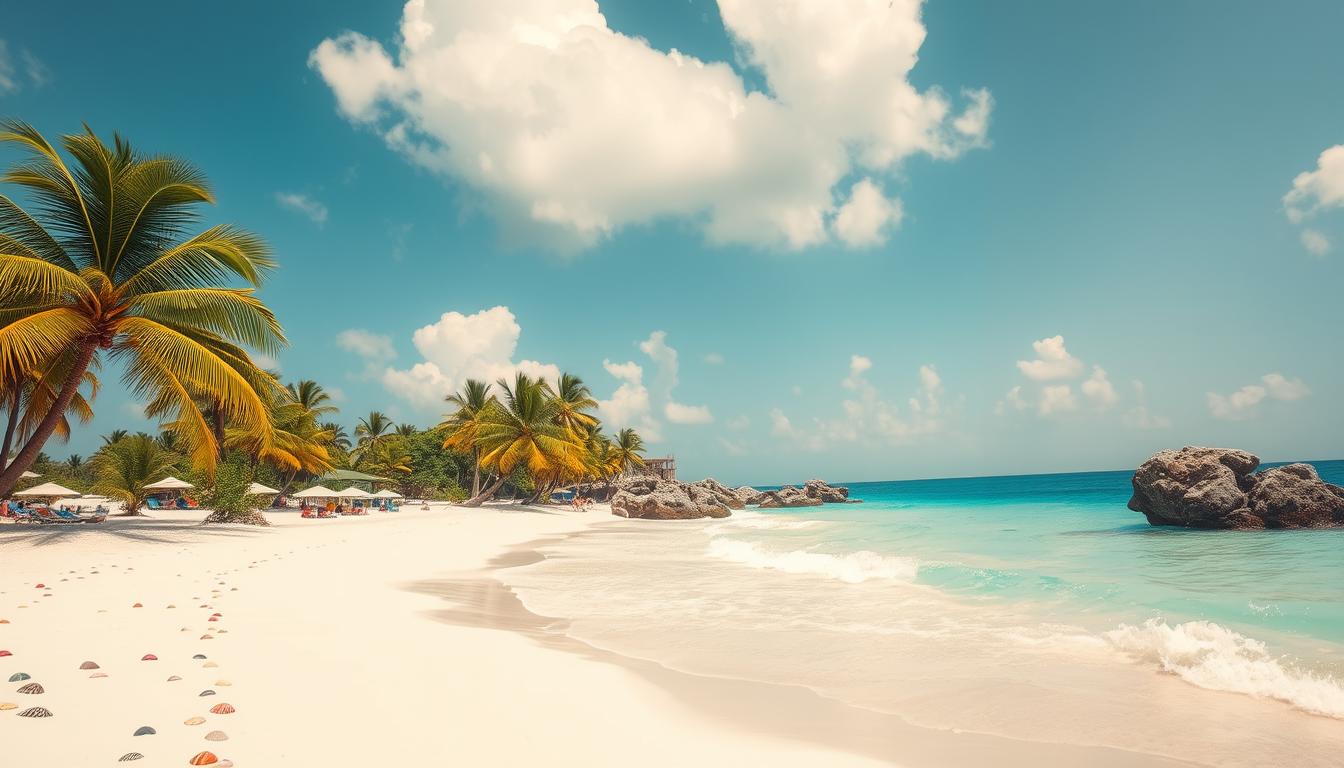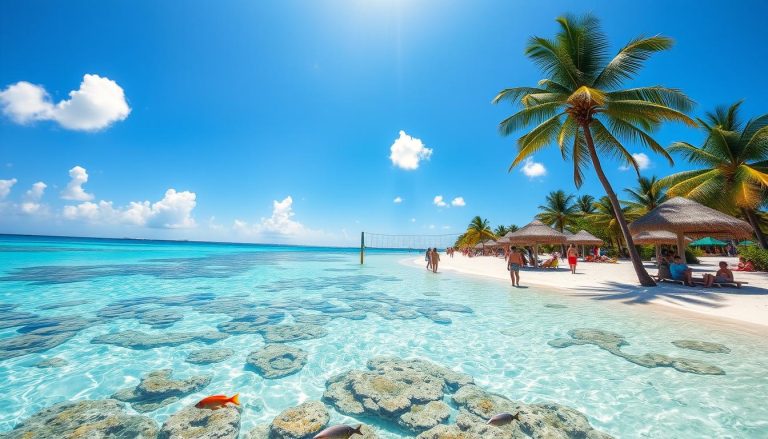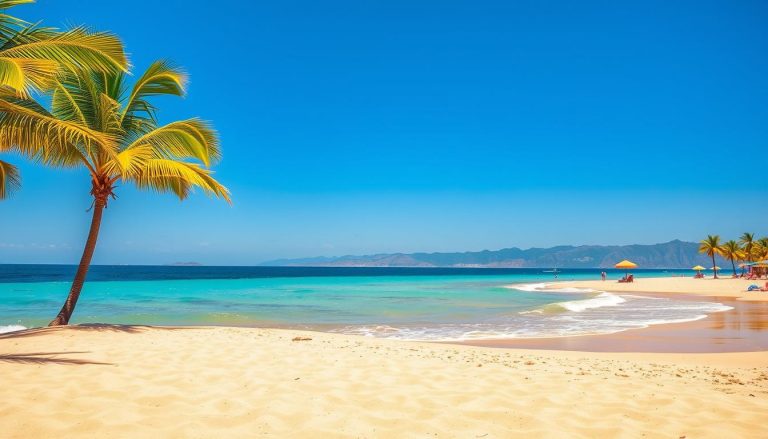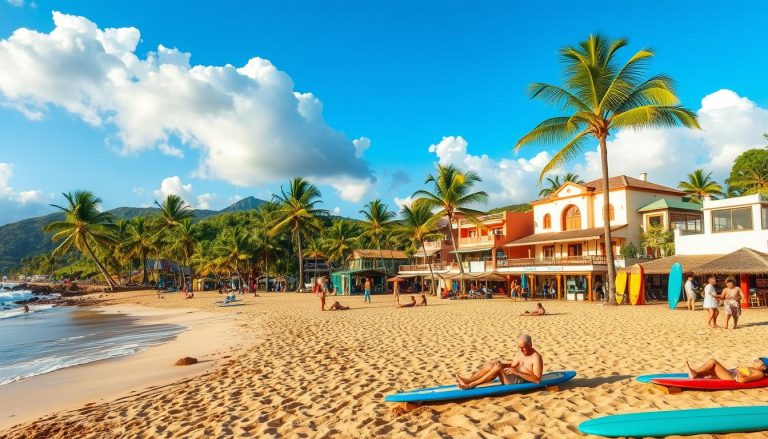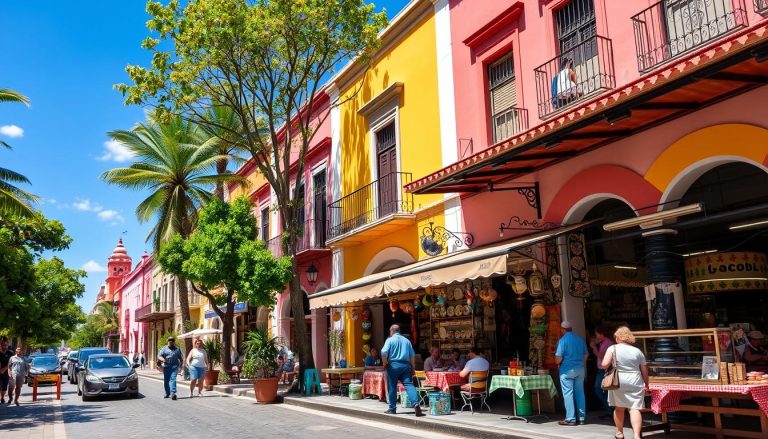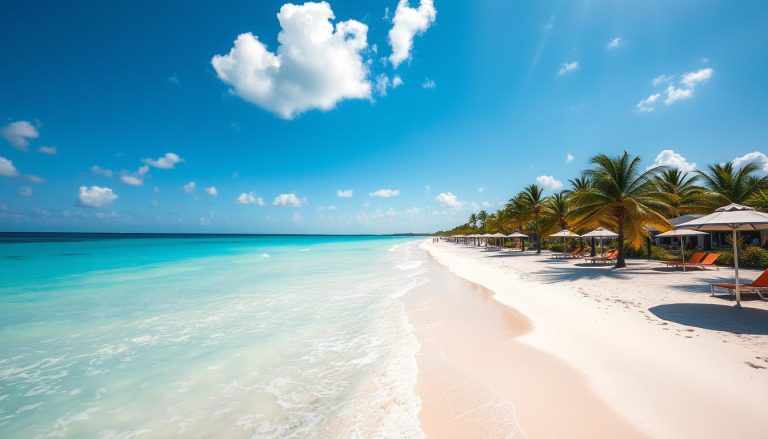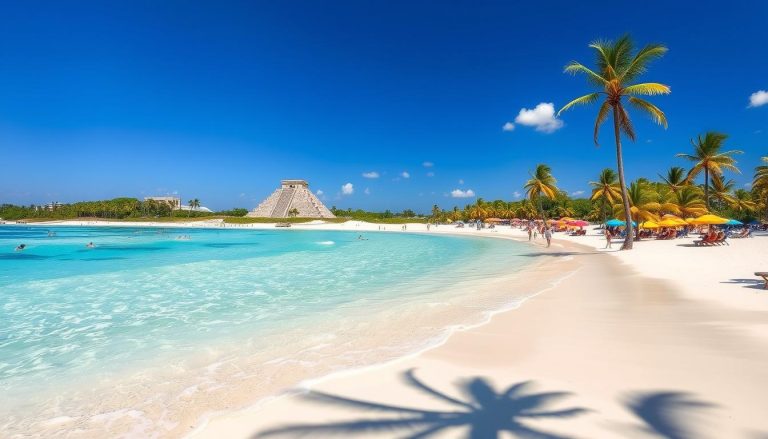Imagine a place where the crystal-clear Caribbean waters meet ancient Mayan ruins. Here, pristine beaches and lush jungle landscapes blend perfectly. This is Tulum, a captivating destination that draws travelers seeking unforgettable experiences. But what makes Tulum special, and what are the top things to do? Let’s explore this enchanting Mexican paradise together.
As you step into Tulum, you’ll find a unique mix of old and new. The remnants of a bygone Mayan civilization stand alongside modern luxury. This coastal gem, just a couple of hours south of Cancun, has evolved from a bohemian hideaway to a top destination. It welcomes a wide range of travelers, from those seeking relaxation to adventure-seekers and culture enthusiasts.
Imagine experiencing Tulum’s natural wonders, historic sites, and culinary delights in one trip. Would you be tempted to explore this enchanting destination? In the following sections, we’ll reveal the top things to do in Tulum. We’ll guide you through must-see attractions, thrilling adventures, and unforgettable experiences that await.
Key Takeaways
- Tulum offers a unique blend of pristine beaches, ancient Mayan ruins, and natural wonders.
- The destination has evolved from a bohemian getaway to a popular tourist destination with boutique properties and Instagram-worthy designs.
- Key attractions include the beach, cenotes, Mayan ruins, and eco-friendly experiences, catering to various travel styles.
- Tulum is known for its postcard-perfect white sandy beaches, warm turquoise waters, and lush tropical jungle.
- The town of Tulum Centro provides a more local and affordable experience compared to the beach area.
Discovering Paradise: An Introduction to Tulum
Tulum is a top spot on Mexico’s Caribbean coast, known for its stunning beauty and rich history. It’s about 130 km south of Cancun, making it easy to get to. The Cancun International Airport (CUN) is the main entry point for those visiting.
Location and Getting There
Tulum sits on the Yucatán Peninsula, surrounded by beautiful beaches and clear waters. Most people fly into Cancun International Airport, then take a 1.5-hour drive to Tulum. You can choose from shared shuttles or private transfers to get to your accommodation.
Best Time to Visit
The best months to visit Tulum are November to February. The weather is perfect, with temperatures between 75°F and 84°F. But, this time is also the busiest and most expensive.
If you want to avoid the crowds, consider visiting in March to May or September to October. The weather is still nice, and prices are lower.
What Makes Tulum Special
Tulum is special because it mixes luxury with a rustic feel. It’s famous for its eco-friendly resorts that blend into nature. You can enjoy the beaches, explore ancient Mayan ruins, and swim in cenotes.
It’s a place where you can relax and learn about culture. Tulum is all about finding a balance between nature and history.
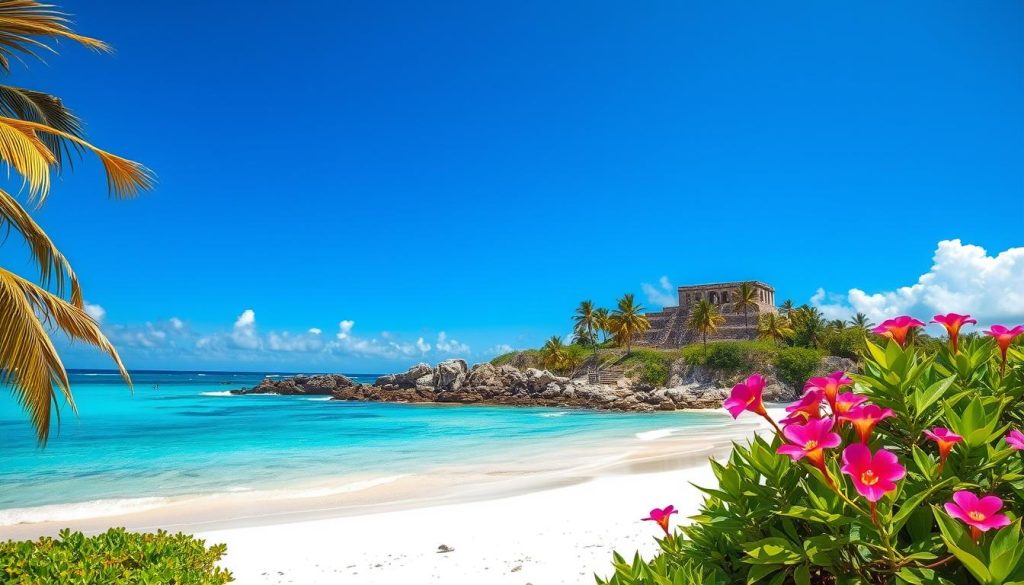
Tulum is perfect for anyone looking for a beach getaway, history, or eco-friendly travel. It has something for everyone. Its natural beauty, rich culture, and green focus make it a paradise to explore.
Exploring Tulum's Pristine Beaches
Tulum’s beaches are famous for their beauty. They have white sands and blue waters that attract visitors worldwide. Whether you want to relax or have fun, Tulum’s beaches have it all.
Popular Beach Areas
Playa Paraiso, Las Palmas, and Playa Ruinas are Tulum’s top beaches. Playa Paraiso is great for swimming and sunbathing. Las Palmas is quieter, perfect for those who prefer peace.
Playa Ruinas is close to the Tulum Ruins. It has amazing views of ancient Mayan structures.
Beach Clubs and Amenities
Beach clubs like Papaya Playa Project, Taboo Tulum, and Nomade Tulum offer many amenities. They have loungers, cabanas, restaurants, and bars. You can enjoy food and drinks while taking in the ocean views.
Swimming and Water Activities
Tulum’s waters are perfect for swimming and other water sports. You can swim, snorkel, kitesurf, kayak, or paddleboard. The Yal-Ku lagoon is famous for snorkeling, with lots of colorful fish.
Many hotels and resorts in Tulum have private beaches. But, the public beaches are just as beautiful and cheaper. They offer a true Tulum beach experience.
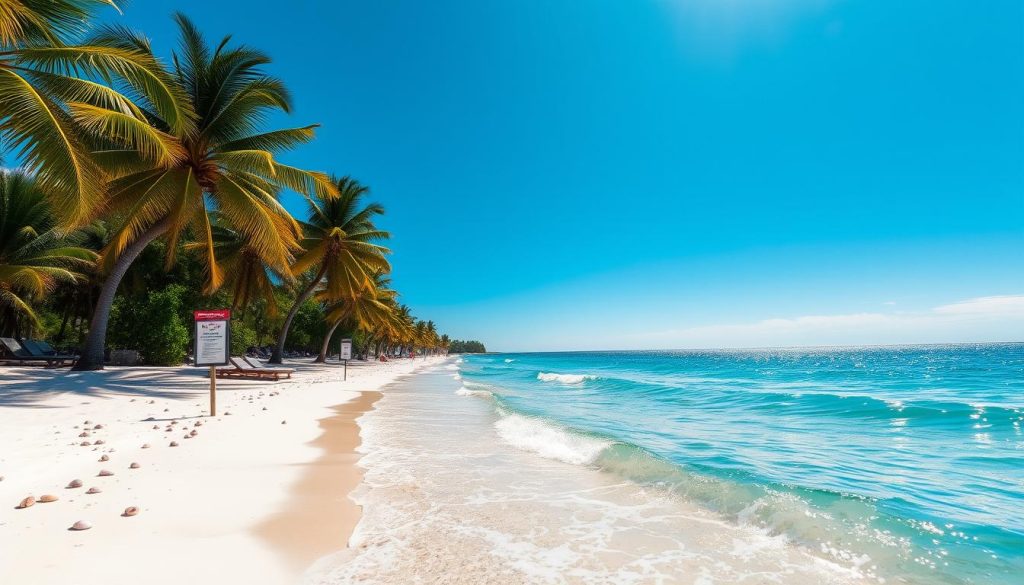
“The beaches of Tulum are like a dream come true – the perfect blend of tranquility, natural beauty, and endless opportunities for adventure.”
Ancient Mayan Heritage: The Tulum Ruins
Tulum, Mexico, is famous for its ancient Mayan history. The Tulum ruins are at the center of this fascinating story. These sites date back to the 13th-15th centuries, when the Mayans were at their strongest. They sit on limestone cliffs, overlooking the turquoise Caribbean Sea.
Visitors can see the past and explore the remains of a once-thriving coastal city. For a more secluded adventure, the Coba ruins are just 45 minutes away. Here, you can climb the Nohoch Mul Pyramid for stunning views of the jungle.
The Coba ruins also have ancient Mayan roads, or “sacbe,” to explore by bike or guided tour. Another hidden treasure is the Muyil ruins, in the Sian Ka’an Biosphere Reserve. This site shows early Mayan settlements, offering a peaceful and unique experience.
| Tulum Ruins | Coba Ruins | Muyil Ruins |
|---|---|---|
| Oceanfront location with stunning views | Nohoch Mul Pyramid, the tallest in the Yucatán | Part of the Sian Ka’an Biosphere Reserve |
| Dates back to 13th-15th centuries | Extensive network of ancient Mayan roads | Showcases early Mayan settlements |
| Well-preserved Mayan architecture | Can be explored by bike or guided tour | Offers a more secluded archaeological experience |
Exploring the Tulum ruins, Coba, or Muyil ruins will amaze you. Each site offers a glimpse into the Mayan civilization’s achievements. It’s a journey through time, showcasing the region’s rich cultural heritage.
“The Tulum ruins are a must-see for anyone visiting Tulum. The stunning oceanfront location and well-preserved Mayan architecture make it a truly breathtaking experience.”
Cenotes: Natural Swimming Pools of the Yucatán
Tulum is famous for its stunning cenotes, natural sinkholes filled with clear water. These sacred spots were loved by the ancient Maya. They give visitors a chance to see an underground world full of wonders and life.
Most Popular Cenotes
The Dos Ojos is a twin cenote system that’s breathtaking. The Gran Cenote is huge and beautiful. The Casa Cenote is cozy, and the Calavera has a cave-like entrance and clear waters.
Safety Tips and What to Bring
- Wear water shoes or sandals to safely walk on the rocky terrain.
- Don’t wear sunscreen, as it can harm the ecosystem.
- Always follow local rules and listen to the cenote staff.
- Bring towels, water, and cash for entrance fees (150 to 500 pesos).
- Some cenotes have amenities like lockers and life jacket rentals.
Best Times for Visiting
The best times to visit are early morning or late afternoon. This is when it’s less crowded and the light is beautiful. Most cenotes are open from 8 a.m. to 5 p.m., with some open longer or for camping.
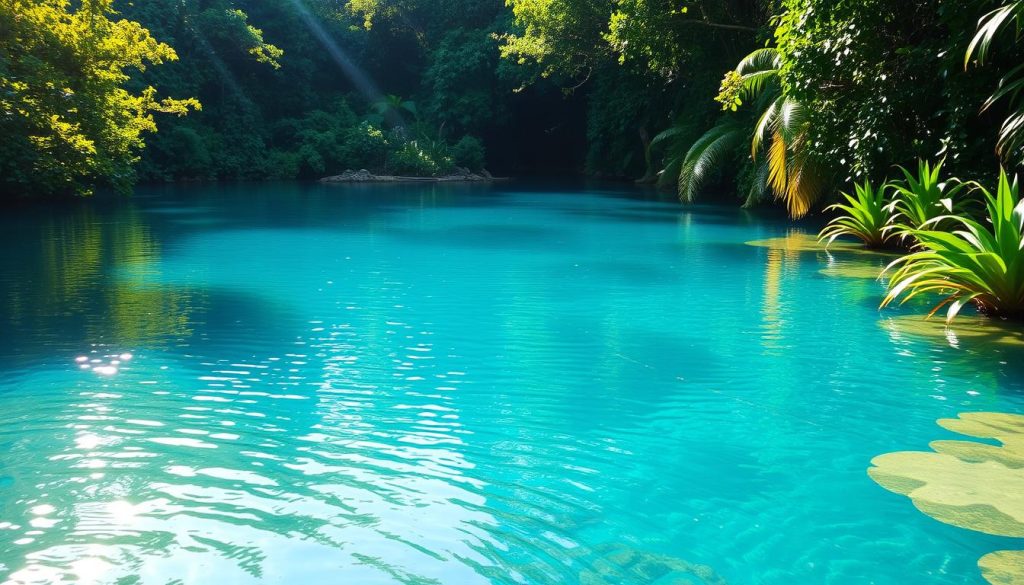
Visiting the Yucatán’s cenotes is a must in Tulum. It’s a chance to dive into the region’s Mayan history and natural beauty. Whether you want to swim, have an adventure, or find peace, these spots will amaze and inspire you.
Tulum, Mexico: Best Things to Do - Top Picks
Tulum is a gem in Mexico’s Riviera Maya. It combines ancient Mayan history, natural beauty, and eco-tourism. Visitors can explore the Sian Ka’an Biosphere Reserve or enjoy yoga retreats. It’s a place that promises unforgettable moments for everyone.
The Sian Ka’an Biosphere Reserve is a UNESCO World Heritage Site. It’s home to a wide variety of wildlife, including jaguars and spider monkeys. You can also go canoeing, kayaking, or hiking in its mangrove forests and lagoons.
The Azulik Uh May offers a unique cultural experience. It’s an artistic jungle retreat where you can learn about Mayan traditions. Enjoy temazcal ceremonies and Mayan spa treatments in a stunning setting.
Adventure lovers will find plenty to do in Tulum. You can try kitesurfing, paddleboarding, or scuba diving. The Mesoamerican Barrier Reef is nearby, and the cenotes are breathtaking.
Tulum is also great for those looking to relax. Its beachfront yoga studios and wellness retreats are perfect for self-discovery. Enjoy yoga, meditation, and Ayurvedic treatments with ocean views.
The food in Tulum is amazing, with many local Yucatecan dishes to try. You can go on gourmet food tours or cooking classes. Learn to make traditional Mayan meals with fresh ingredients.
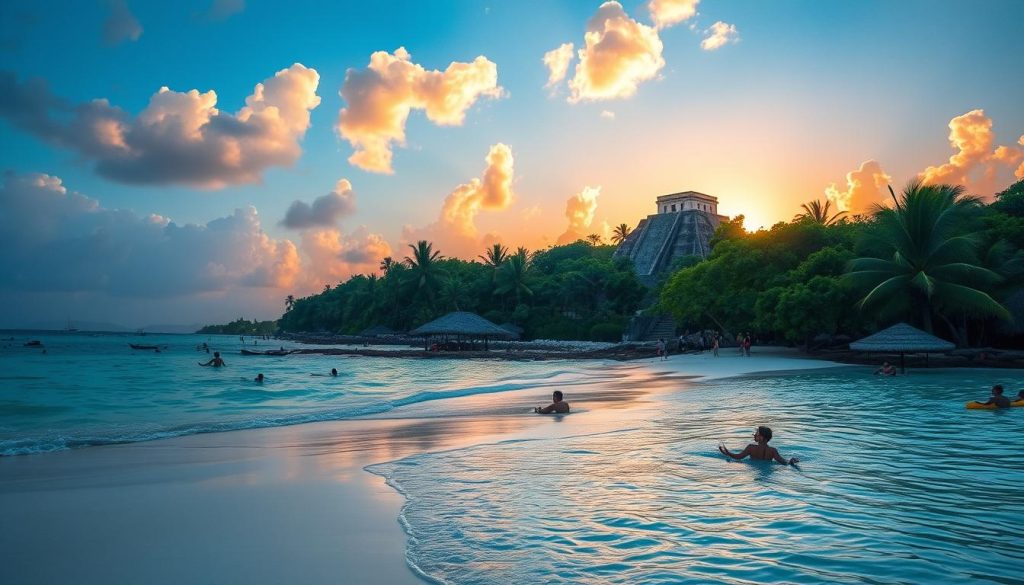
Tulum has something for everyone, from culture to outdoor adventures to wellness. It’s a place that offers a memorable and transformative experience. Discover the best of Tulum and its activities.
Exploring Tulum Town (Centro)
Tulum town, or Centro, is more than just beaches and ruins. It offers a real, affordable experience. You’ll find colorful street art, local markets, and shops with unique goods that show the town’s lively culture.
Shopping and Local Markets
Tulum town is great for shoppers. You’ll find local markets and shops with work by Mexican artisans. Check out the Tulum Pueblo Craft Market or the Saturday market for handmade items.
Visit Kaahal Home for home decor, Mexic-Arte for Mexican crafts, and Auras for eco-friendly clothes. These places are run by local designers.
Cultural Attractions
The town has a rich cultural scene. Small museums and galleries show off the Mayan heritage and modern art. Don’t miss Casa Hernandez Gallery for Talavera pottery and ceramics.
Join local festivals and events to feel the town’s energy. The annual downtown celebrations are a highlight.
Transportation Tips
Getting around Tulum town is simple. You can rent a bike or take a taxi. Bikes are often free at hotels.
Taxis are available, but prices can be high. Always negotiate a fair price. The town is easy to explore on foot or by bike, with areas like La Veleta and Aldea.
Tulum’s Centro neighborhood is a must-see. It offers a budget-friendly experience, cultural attractions, and a lively atmosphere. You’ll leave with unforgettable memories.
Adventure Activities and Eco-Tourism
Tulum, Mexico, is a hotspot for adventure and eco-tourism. Kitesurfers love it for the steady winds. Schools there teach beginners how to kite.
The Mesoamerican Barrier Reef is nearby, perfect for diving and snorkeling. You can see sea turtles and colorful fish in the clear waters.
The diving season in Tulum is from May to November. You might see whale sharks from June to September. Exploring cenotes or visiting eco-parks like Xel-Há and Xcaret are great eco-adventures.
Activities like kayaking in mangrove forests and birdwatching tours are also available. You can even help with sea turtle conservation. Tulum promotes sustainable tourism, connecting you with nature and supporting local communities.
Looking for excitement or a calm nature trip? Tulum has it all. Discover its biodiversity and Mayan heritage for a memorable experience.
“Tulum is a place where you can truly immerse yourself in the natural wonders of the Yucatán Peninsula, while also supporting the local community and sustainable tourism efforts.”
Sian Ka'an Biosphere Reserve Experience
The Sian Ka’an Biosphere Reserve is a natural wonder on Mexico’s Caribbean coast. It covers over 1.3 million acres. This UNESCO World Heritage site has many ecosystems, like tropical forests and mangroves.
Exploring this reserve, you’ll see lots of wildlife. This includes manatees, crocodiles, dolphins, and many bird species.
Wildlife Spotting
The Sian Ka’an Biosphere Reserve is famous for its wildlife. You can see dolphins and manatees in the mangrove canals. Or, you might spot jaguars and colorful birds in the forests.
Remember to bring your camera. The wildlife here is truly amazing.
Guided Tours Options
It’s best to explore the reserve with a local guide. There are two main entry points: Punta Allen and Muyil. Punta Allen tours focus on the marine side, with snorkeling and boat rides.
Muyil tours are more accessible. They include ancient Mayan canals and the Muyil Ruins. A guided tour is a great way to see the reserve’s natural and cultural wonders.
Conservation Efforts
The Sian Ka’an Biosphere Reserve is a natural paradise and a model for conservation. It protects endangered species and supports local communities. Visitors can join educational programs to learn about eco-conservation.
By supporting these efforts, you help preserve the reserve for future generations.
